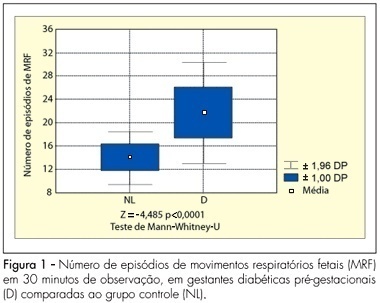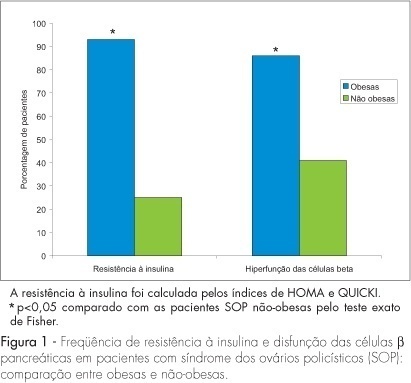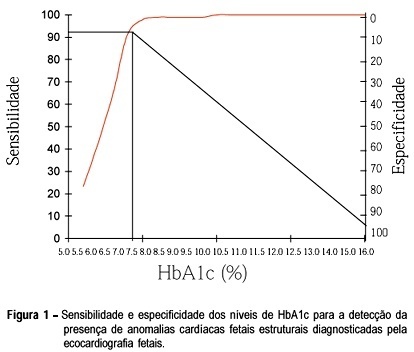Summary
Revista Brasileira de Ginecologia e Obstetrícia. 2007;29(7):352-357
DOI 10.1590/S0100-72032007000700005
PURPOSE: to analyze the pattern of fetal breathing movements (FBM) in diabetic pregnant women in the third trimester of pregnancy. METHODS: sixteen pregestational diabetic and 16 nondiabetic (control group) pregnant subjects were included fulfilling the following criteria: singleton, between 36-40 weeks of gestation, absence of other maternal diseases and absence of fetal anomalies. The fetal biophysical profile (FBP) was performed to evaluate the following parameters: fetal heart rate, FBM, fetal body movements, fetal tone and amniotic fluid index. The FBM was evaluated for 30 minutes, period when the examination was integrally recorded in VHS video for posterior analysis of the number of FBM episodes, the duration of each episode and the fetal breathing movements index (BMI). The BMI was calculated by the formula: (interval of time with FBM/total time of observation) x 100. At the beginning and in the end of the FBP maternal glucose levels were checked. The results were analyzed by the Mann-Whitney U-test and the Fisher exact test, adopting a level of significance of 5%. RESULTS: the glucose levels demonstrated significantly superior average in the diabetic group (113.3±35.3 g/dL) in relation to the normal group (78.2±14.8 g/dL, p<0.001). The average of the amniotic fluid index was higher in the group of the diabetic cases (15.5±6.4 cm) when compared with controls (10.6±2.0 cm; p=0.01). The average of the number of FBM episodes was superior in the diabetic ones (22.6±4.4) in relation to controls (14.8±2.3; p<0.0001). The average of the BMI in the diabetic patients (54.6±14.8%) was significantly higher than that in the control group (30.5±7.4%, p<0.0001). CONCLUSIONS: the elevated blood glucose levels can be associated with a different pattern in the FBM of diabetic mothers. The use of this parameter of the FBP, in the obstetric practice, must be considered with concern in diabetic pregnancies.

Summary
Revista Brasileira de Ginecologia e Obstetrícia. 2007;29(5):253-259
DOI 10.1590/S0100-72032007000500006
PURPOSE: to evaluate the insulin therapy protocol and its maternal and perinatal outcome in patients with clinical or gestational diabetes in a high risk reference service. METHODS: descriptive and prospective study including 103 pregnant women with gestational or clinical diabetes treated with insulin and attended by the reference service from October 2003 to December 2005. Gemellarity, miscarriages, unfinished prenatal care and deliveries not attended by the service were excluded. The gestational age at the beginning of the treatment, dosage, doses/day, increment of insulin (UI/kg), glycemic index (GI) and perinatal outcomes were compared. ANOVA, Fisher’s exact test and Goodman’s test considering p<0.05 were used. RESULTS: multiparity (92 versus 67.9%), pre-gestational body mass index (BMI) >25 kg/m² (88 versus 58.5%), weight gain (WG) <8 kg (36 versus 17%) and a high increment of insulin characterized the gestational diabetes. For the patients with clinical diabetes, despite the highest GI (120 mg/dL (39.2 versus 24%)) at the end of the gestational period, insulin therapy started earlier (47.2 versus 4%), lasted longer (56.6 versus 6%) and higher doses of insulin (92 versus 43 UI/day) were administered up to three times a day (54.7 versus 16%). Macrosomia was higher among newborns from the cohort of patients with gestational diabetes (16 versus 3.8%), being the only significant neonatal outcome. There were no neonatal deaths, except for one fetal death in the cohort of patients with clinical diabetes. There were no differences in the other neonatal complications in both cohorts, and most of the newborns were discharged from hospital up to seven days after delivery (46% versus 55.8%). CONCLUSIONS: the analysis of these two cohorts has shown differences in the insulin therapy protocol in quantity (UI/day), dosage (UI/kg weight) and number of doses/day, higher for the clinical diabetes cohort, and in the increment of insulin, higher for the gestational diabetes cohort. Indirectly, the quality of maternal glycemic control and the satisfactory perinatal outcome have proven that the treatment protocol was adequate and did not depend on the type of diabetes.
Summary
Revista Brasileira de Ginecologia e Obstetrícia. 2007;29(3):141-146
DOI 10.1590/S0100-72032007000300005
PURPOSE: to evaluate the effect of obesity on beta-cell function in patients with polycystic ovary syndrome (PCOS). METHODS: this cross-section study evaluated 82 patients with PCOS selected consecutively, at the moment of the diagnosis. We compared 31 PCOS obese women (BMI >30 kg/m²) to 51 age-matched PCOS nonobese patients (BMI <30 kg/m²). Using fasting glucose and insulin levels, homeostatic model assessment values for insulin resistance (HOMA-IR and QUICKI) and percent beta-cell function (HOMA-%beta-cell) were calculated. As secondary variables, the age at PCOS diagnosis, age of menarche, hormonal levels (testosterone, prolactin, FSH and LH), total cholesterol, triglycerides, HDL cholesterol and LDL cholesterol were also analyzed. RESULTS: menarche was significantly earlier in obese PCOS patients (11.7±1.8 years) than in nonobese patients (12.67±1.86 years) (p<0.05). Obese patients presented lower LH levels (7.9±5 mIU/mL) than did nonobese patients (10.6±6 mIU/mL) (p<0.05). Both groups presented mean HDL cholesterol levels below 50 mg/dL. Obese patients presented significantly higher baseline insulin levels (32.5±25.2 mIU/mL) and fasting blood glucose levels (115.9±40.7 mg/dL) than did nonobese patients (8.8±6.6 mIU/mL and 90.2±8.9 mg/dL, respectively) (p<0.01). Of the obese PCOS patients, 93% presented insulin resistance versus 25% of nonobese PCOS patients (p<0.01). Eighty-six perecent of the obese women had hyperfunction of beta-cell versus 41% of nonobese with PCOS (p<0.0001). CONCLUSIONS: obese PCOS patients presented higher prevalence of insulin resistance and hyperfunction of beta-cell than did nonobese PCOS patients.

Summary
Revista Brasileira de Ginecologia e Obstetrícia. 1998;20(5):237-243
DOI 10.1590/S0100-72031998000500002
We analyze prospectively the existence of a relationship between the mother's glycemic control, in the first half of pregnancy, and the occurrence of abnormal fetal cardiac abnormalities, in pregnant women with diabetes mellitus. In 127 pregnant women, the level of glycosylated hemoglobin was determined on the first visit during prenatal care. Nine patients had type I diabetes, 77 type II and 41 gestational diabetes mellitus (GDM). All mothers were submitted to detailed fetal echocardiography, during the 28th ± 4.127 week of gestation. In 31 (24.4%) of the 127 fetuses cardiac anomalies were detected. In 10 (7.87%) an isolated cardiac anomaly was identified. Mean HbA1c in the group of pregnant women without cardiac anomalies (5.64%) was statistically different from the group with anomalies (10.14%) (p<0.0001). The receiver-operator characteristic, representing the balance between sensitivity (92.83%) and specificity (98.92%) in the diagnosis of structural cardiac abnormalities, showed a cut-off point at the 7.5% HbA1c level. In nine of ten fetuses with structural cardiac anomalies, the maternal level of HbA1c was higher than 7.5%. The difference between means of the groups with and without myocardial hypertrophy diagnosed as isolated anomaly (MCHP) was not statistically significant, when considering both type II diabetes and GDM subgroups. In conclusion, levels of HbA1c higher than 7.5% were associated with most cases of echocardiographycally diagnosed structural cardiac anomalies. On the other hand, this test was not useful to discriminate conceptus with MCHP.

Summary
Revista Brasileira de Ginecologia e Obstetrícia. 2006;28(8):460-466
DOI 10.1590/S0100-72032006000800004
PURPOSE: to assess the performance of lamellar body count compared to the shake (Clements) test in the prediction of fetal lung maturity in diabetics. METHODS: prospective study of 62 patients who underwent amniocentesis between the 26th and 39th week of pregnancy. Immediately after collection, the amniotic fluid sample was submitted to the shake test and lamellar body count. Deliveries occurred within three days of amniocentesis. Immature test results (absence of a complete bubble ring in the third tube for the shake test and less than 50,000 lamellar bodies) were confronted with the occurrence of pulmonary immaturity in the neonate (respiratory distress syndrome). The performance of both tests was compared using the chi2 test and p<0.05 was considered to be significant. RESULTS: seven infants had respiratory distress syndrome (11.3%). The lamellar body count and shake test were similar regarding sensitivity (100 vs 71.4%, respectively) and negative predictive value (100 vs 93.5%). Lamellar body count was superior as regards specificity (87.3 vs 52.7%, p=0.0001), positive predictive value (50 vs 16.1%, p=0.017), and accuracy (88.7 vs 54.8%, p<0.001). CONCLUSIONS: lamellar body count is a simple and accurate method of assessing fetal lung maturity. It performs slightly better than the shake test in terms of specificity, positive predictive value and accuracy, with the advantage of not requiring manipulation or reagents. Similar to the shake test, lamellar body count has a high-negative predictive value: mature results (50,000 or more) indicate thar the infant will not have hyaline membrane.
Summary
Revista Brasileira de Ginecologia e Obstetrícia. 2006;28(8):453-459
DOI 10.1590/S0100-72032006000800003
PURPOSE: to analyze the fetal heart rate (FHR) and umbilical artery Dopplervelocimetry between 18th and 20th weeks of gestation in pregnant women complicated by pregestational diabetes mellitus. METHODS: twenty-eight pregnancies with pregestational diabetes and 27 normal pregnant women were analyzed prospectively, in a cross-sectional and case-control study. The inclusion criteria were the following: singleton pregnancy between 18 and 29 weeks, no other associated maternal diseases and no fetal abnormality. Ultrasonography was performed and FHR was calculated by the interval between the beginnings of two consecutive cardiac cycles, in the three umbilical artery Doppler sonograms, obtained in the umbilical cord near to the placental insertion, using color Doppler. Five consecutive FHR cycles from each sonogram were measured, to analyze mean FHR and its variation. The following Doppler indices were studied: systolic/diastolic ratio, pulsatility index (PI) and resistance index (RI). Student's t test and Mann-Whitney Utest were applied to comparative study. p values were considered significant when p<0.05. Results: no significant difference was observed in mean FHR between the studied groups (diabetic group: 149.2 bpm, control group: 147.2 bpm; p = 0.12). FHR variation revealed similar results between the groups (diabetic group: 5.3 bpm; control group: 5.3 bpm; p=0.50). No significant difference was found in the Doppler indices S/D (p=0.79), PI (p=0.25) and RI (p=0.71) between the groups. CONCLUSIONS: the absence of differences in FHR characteristics between the 18th and 20th gestational weeks indicates similar neurological maturation of FHR regulatory systems in this period, between fetuses of diabetic mothers and controls. Abnormalities in the uteroplacental resistance were not identified in the studied period, in pregnancies complicated by pregestational diabetes.
Summary
Revista Brasileira de Ginecologia e Obstetrícia. 2006;28(3):179-183
DOI 10.1590/S0100-72032006000300007
PURPOSE: to diagnose and treat diabetic pregnant women with antiphospholipid antibodies and to describe the gestational and perinatal results. METHODS: we evaluated 56 gestational and pregestational diabetic women who were attended at one specialized prenatal care unit, between July 2003 and March 2004. All of them had a blood test to quantify antiphospholipid antibodies. If positive, they were treated with heparin and aspirin at low doses and the usual treatment for diabetes. We calculated the prevalence and 95% confidence interval for all and also those for the pregestational ones. The characteristics of the pregnancies and the newborns are described. RESULTS: antiphospholipid antibodies prevalence among the diabetic pregnant women was 7% (95% CI - 0.1 to 13.9). Among pregestational diabetic women it was 12% (95% CI - 0.2 to 23.3). Among the diabetic women with antiphospholipid antibodies the duration of disease was five years or more. Maternal age in positive antiphospholipid antibodies diabetics ranged from 27 to 38 years; one was primiparous, another was secundiparous and two were multiparous. CONCLUSION: antiphospholipid antibodies prevalence in diabetic pregnant women was similar to that in the general population and lower than that of the pregestational diabetic women.
Summary
Revista Brasileira de Ginecologia e Obstetrícia. 1999;21(7):393-397
DOI 10.1590/S0100-72031999000700005
Purpose: to evaluate a possible relationship between fetal malformations (FM) and the use of sulfonylureas (SF) by diabetic pregnant women. Methods: we retrospectively studied 35 type 2 diabetic pregnant women followed at the Pathological Prenatal Care Outpatient Clinic of the University Hospital, Faculty of Medicine of Ribeirão Preto, from 1993 to 1995. Twenty-two of these women had been inadvertently using sulfonylureas during the 1st trimester of gestation (SF group). We determined their prevalence of FM and compared it to that observed for pregnant diabetic women who were only on diet or insulin therapy (group C). We also analyzed other variables such as time of disease, age, metabolic control, and prenatal care. Results: there was no significant difference between groups in terms of age range, duration of diabetes, glycemic control, or early start of prenatal care, with the prevalence of FM being similar for the two groups (8.3% in group C and 13.6% in group SF). The malformations observed in group SF were: renal agenesis, pulmonary hypoplasia and ribbon gonads (patient 1); short limbs and abnormally implanted toes (patient 2); cleft palate, low implanted ears, neck webbing and saddle nose (patient 3), and micrognathia, dysplastic ears, imperforate anus, hypospadia, polydactily, ventricular septal defect and atrial septal defect (patient 4) in group C. Conclusions: these data do not allow us to attribute the malformations detected in group SF to the use of sulfonylureas, although not usually described alterations in diabetic embryopathy occurred in this group.